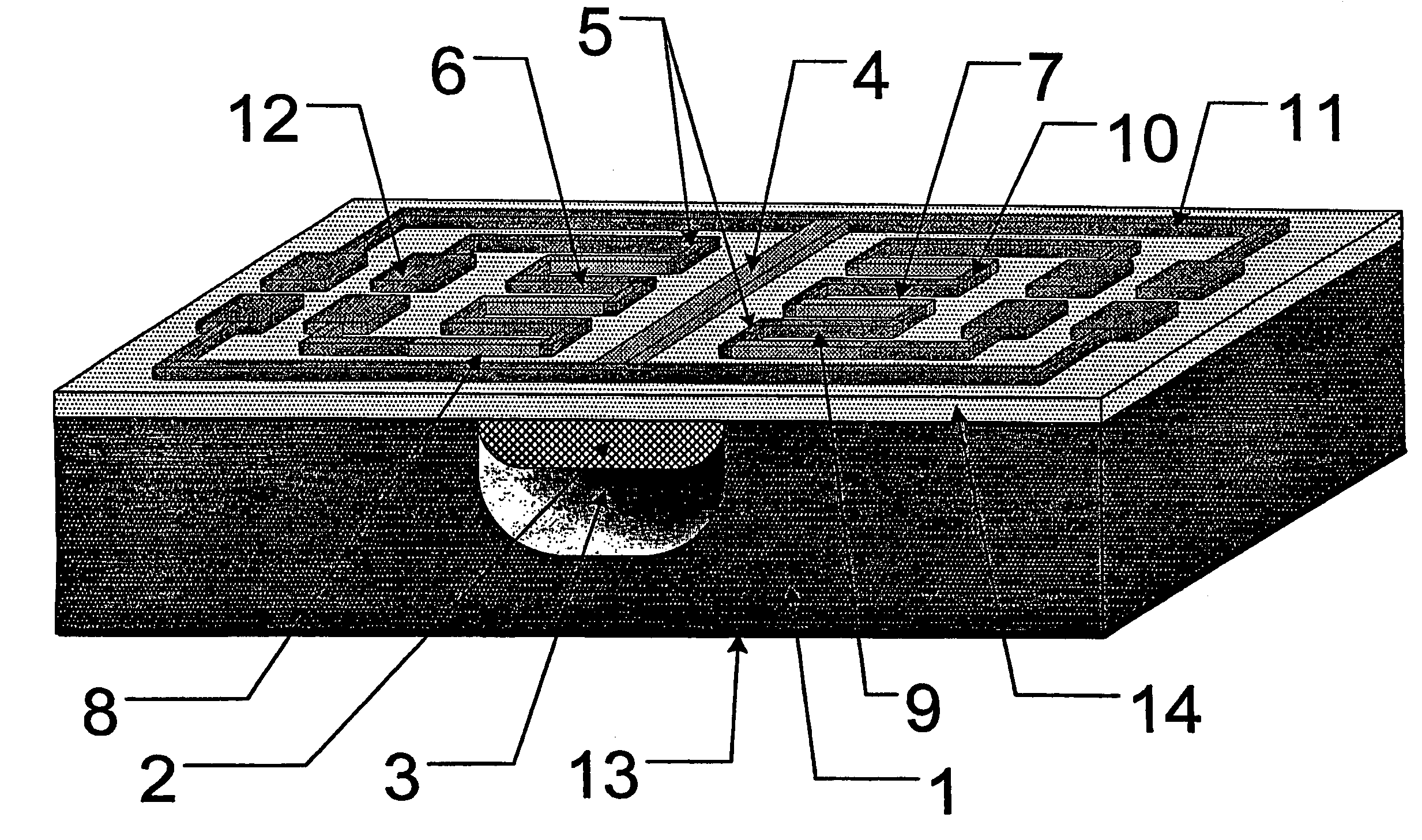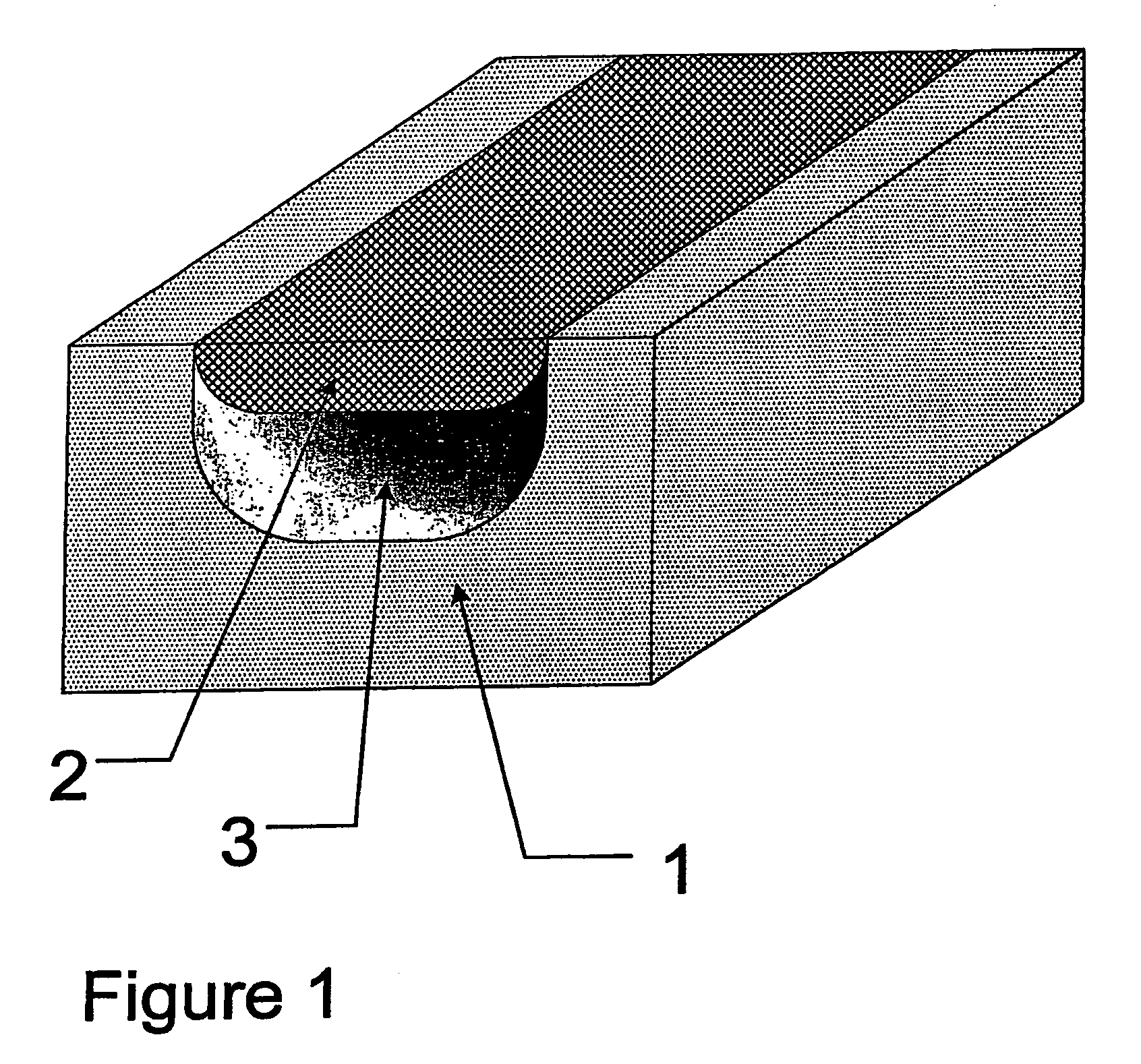Low power silicon thermal sensors and microfluidic devices based on the use of porous sealed air cavity technology or microchannel technology
a microfluidic device and low-power technology, applied in fluid speed measurement, optical radiation measurement, optical light guide, etc., can solve the problems of difficult processing after membrane formation and important drawbacks, and achieve the effect of increasing device sensitivity and reducing power consumption
- Summary
- Abstract
- Description
- Claims
- Application Information
AI Technical Summary
Benefits of technology
Problems solved by technology
Method used
Image
Examples
example 1
[0028]The process used for the formation of sealed or open microfluidic channels (3)(16) on a silicon substrate (1)(15). The porous silicon capping layer is planar with the silicon substrate. The process used is a combination of electrochemical dissolution and electropolishing of silicon by using a current density below (for porous silicon formation) or above (for electropolishing) a critical value. The fabrication process is the following: an ohmic contact (26) is first formed on the back side of the said silicon substrate (1)(15), used as anode in the electrochemical dissolution of silicon in order to form locally on silicon the porous silicon layer (2)(17). On the front side of the silicon substrate a masking layer for local porous silicon formation is then deposited and patterned. The porous silicon layer (2)(17) used as capping of the microchannel (3)(16) and the microchannel are formed in one electrochemical step by first using a current density below the critical value for el...
example 2
[0029]The fabrication process of a thermal flow sensor based on the process described in Example 1. It comprises the following steps: a) Creation of an ohmic contact (13) on the back side of the said silicon substrate (1), b) deposition and patterning of a masking layer for porous silicon formation in the front side of the silicon substrate, c) porous silicon (2) formation locally on the silicon substrate using electrochemical dissolution of bulk silicon. The current density used in the electrochemical process is below the value of the current density in the electropolishing regime, d) electrochemical dissolution of silicon under the porous silicon layer, using the electropolishing conditions, i.e. a current density above a critical value, so as to form a cavity (3) below a suspended porous silicon membrane (2), e) deposition of a thin dielectric layer for electrical isolation (14), f) deposition and patterning of polycrystalline silicon, which is then doped with p-type dopants, in ...
example 3
[0030]The fabrication process of a thermal microfluidic sensor based on the process described in Example 1. It comprises the following steps: a) creation of a microfluidic channel (16) sealed with a porous silicon layer (17) on the silicon substrate (15), b) deposition of a thin silicon dioxide layer (25) on top of the whole silicon substrate for electrical isolation, c) deposition and patterning of polycrystalline silicon in order to form a heater resistor (20) and two other resistors (21, 22) on its left and right sides, e) deposition and patterning of aluminum in order to form electrical interconnects (24) and metal pads (23) and f) opening of the inlet (18) and outlet (19) of the microchannel (16) by selectively etching locally the top silicon dioxide layer (25) and the silicon layer (15) underneath. On top of the flow sensor a passivation layer is deposited, consisting of silicon oxide or silicon nitride or polyimide.
PUM
| Property | Measurement | Unit |
|---|---|---|
| temperature | aaaaa | aaaaa |
| temperature | aaaaa | aaaaa |
| temperature | aaaaa | aaaaa |
Abstract
Description
Claims
Application Information
 Login to View More
Login to View More - R&D
- Intellectual Property
- Life Sciences
- Materials
- Tech Scout
- Unparalleled Data Quality
- Higher Quality Content
- 60% Fewer Hallucinations
Browse by: Latest US Patents, China's latest patents, Technical Efficacy Thesaurus, Application Domain, Technology Topic, Popular Technical Reports.
© 2025 PatSnap. All rights reserved.Legal|Privacy policy|Modern Slavery Act Transparency Statement|Sitemap|About US| Contact US: help@patsnap.com



